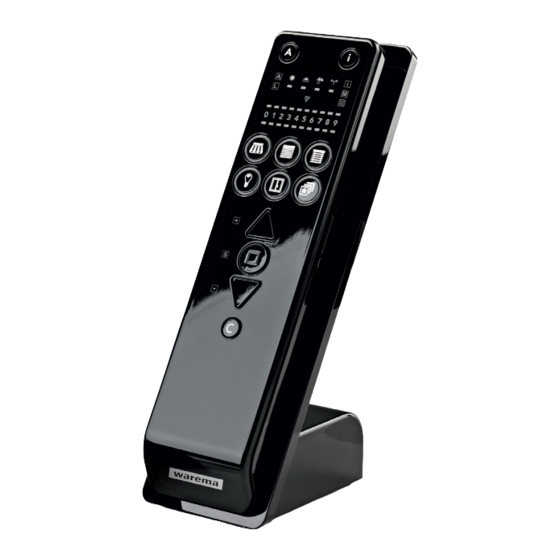
WAREMA WMS Operating And Installation Instructions
Hand-held transmitter
Hide thumbs
Also See for WMS:
- Operating instructions manual (132 pages) ,
- Operating and installation instructions (9 pages) ,
- Operating and installation instructions (6 pages)
Table of Contents
Advertisement
Quick Links
Operating and installation instructions
WAREMA Mobile System
WMS Hand-held transmitter
Keep for future use
Valid from 01 September 2014
General information
Fig. 1
WMS Hand-held transmitter
The WAREMA Mobile System (WMS) Hand-held transmit-
ter is used for the remote control of WAREMA WMS receiv-
ers. The receivers send a confirmation of the received
commands, and the hand-held transmitter indicates that it
received the confirmation.
The WMS Hand-held transmitter supports 5 different prod-
uct types. Ten channels are available per product type and
up to 10 receivers can be learned in each channel.
To operate different products simultaneously and to recall
self-defined states, up to 10 different scenes can be de-
fined. A scene can be used to operate up to 200 receivers
with a single command.
The comfort control functions can be switched on and off
via the WMS Hand-held transmitter. The parameters of the
control functions that are stored in the receiver can be
displayed and changed.
When the WMS Hand-held transmitter operates a product,
it indicates whether the previous operation of the product
was by a control function. If a control function prevents
operation of the product (e.g. a wind alarm), this is also
displayed on the WMS Hand-held transmitter.
Tntended use
This device was developed to control WAREMA Mobile
System (WMS) receivers. The approval of the manufacturer
must be obtained for uses outside of the purposes listed
in these instructions.
890374_b•en•01.09.2014
Safety instructions
C
CAUTIO
The hand-held transmitter is for indoor use
only. It is not water-proof. Do not leave the
transmitter outdoors.
C
CAUTIO
Never activate buttons on your transmitter
arbitrarily without visual contact to the sun
shading product. Children may not play with
this product - remote controls or transmitters
may not get into the hands of children!
Carry out the following steps in the sequence given to
ensure problem-free operation:
Please read these instructions carefully
Insert the batteries
Learn the hand-held transmitter into the receivers
Check that the system is functioning correctly
Commissioning
Films on commissioning can be found at:
http://www.warema.de/inbetriebnahme-
funksysteme
We recommend commissioning using the
WMS studio PC software.
Insert the supplied batteries into the battery compart-
ment as described in the "Maintenance" section. The
device is now ready to operate.
Learn the hand-held transmitter into the receivers. See
the "Commissioning functions" section
(When the receiver is delivered, it does not "know" any
transmitter initially and first needs to learn to which
transmitters it should respond. We refer to this process
as "learning".)
Clways follow the operating and installation instructions
of the receivers.
O
IUTE
In addition, you can obtain the "WMS applica-
tion brochure" with numerous practical exam-
ples of learning, making settings and WMS
networks; the brochure is available free of
charge from your specialist dealer. Alternatively,
the brochure can be downloaded at: http://
www.warema.de → Products → Controls →
WAREMA Mobile System. The WAREMA Mobile
System also enables a wide range of special
functions.
We reserve the right to carry out improvements
1
Advertisement
Table of Contents

Subscribe to Our Youtube Channel
Summary of Contents for WAREMA WMS
-
Page 1: General Information
Please read these instructions carefully The WAREMA Mobile System (WMS) Hand-held transmit- ter is used for the remote control of WAREMA WMS receiv- Insert the batteries ers. The receivers send a confirmation of the received Learn the hand-held transmitter into the receivers... - Page 2 If the hand-held transmitter is in the info or learn mode, the buttons can be used to change or store settings ( light up). Fig. 2 Operating panel of the WMS Hand-held transmitter Comfort button Save and recall comfort positions and scenes Pos. Fig.
- Page 3 Displaying/setting the control functions Select the product type that you would like If you retrofit your products with suitable WMS sensors in to operate. a WMS network, they can be extended and retracted auto- Only those product buttons light up for matically as a function of sunlight, dawn/dusk or precipita- which products have been learned in.
- Page 4 Learning/recalling the comfort positions Button/ Cction/result display A comfort position can be stored for every receiver in the network (e.g. awning half extended). The awning can be E.g. The parameter value of the current control automatically moved to this comfort position at the press function is displayed in the upper row of of a button.
- Page 5 In the following example, a receiver is learned into chan- Button/ Cction/result nel 1 and channel 3. The receiver in channel 1 is then display deleted from channel 3. Using the flashing product button, select the channel into which the previously se- Button/ Cction/result lected product should be grouped.
- Page 6 Calling up scenes Button/ Cction/result display Button/ Cction/result Select the first product type and channel display that should belong to the scene Press the scene button. The button only lights up if at least one scene was stored. E.g. The scene button flashes. The LED below the channel number lights E.g.
-
Page 7: Commissioning Functions
WMS plug receiver for another product type, respective radio network. A hand-held transmitter can the receiver must be deleted out of the network detect WMS receivers and sensors and add them to its entirely and learned in again. network. -
Page 8: Maintenance And Cleaning
If the device is not used for a longer period, please re- WMS Hand-held transmitter 1002 767 move the batteries. Do not use rechargeable batteries. WMS Plug receiver and WMS 1002 771 Cleaning Hand-held transmitter Clean the housing with a microfibre cloth or a soft damp (not learned into each other) cloth.










Need help?
Do you have a question about the WMS and is the answer not in the manual?
Questions and answers